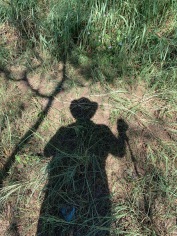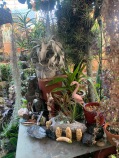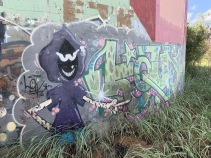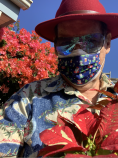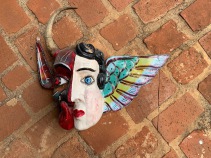Volery Appendex
the following notes were contributed by Debby Benson, from a residential training we did together in New Zealand. They include an excerpt from Arthur Pauls's description of the "technique."
Volery Syndrome
Excerpt from The Philosophy and History Of Ortho-Bionomy by
Arthur Lincoln Pauls p.s 86-87
‘Watch yourself as you get ‘IT’ and allow ‘It’ to get you! I trust you know what I speak about, so let’s begin with the first step. The physical concept of the Volery Syndrome.
- Hold your right hand relaxed, now clench it tight without making a fist. Do it as best you can and leave the rest of your arm relaxed as possible.
- Now, relax your right hand as much as you can and tense your right forearm.
- Relax your right forearm and tighten the upper arm (biceps and triceps), keeping your arm straight and relaxed in other areas.
- Relax your right biceps and triceps and tense the right deltoid shoulder muscles.
- Relax the right shoulder and tense the right shoulder blade (scapular).
- Relax the right shoulder blade and pass the physical tension to the left shoulder blade.
- Repeat in turn now in the left arm but now in reverse order, tense the shoulder, relax, tense triceps and biceps, relax. Tense forearm, relax. Tense fist, relax
Now do it slowly - left to right and back again. Practice it smoothly until you can do it back and forth(still physically) a little like an alternating current, running from the hand, up the arm down the other arm, to the hand and back again.
Now starting out, at the same time in both hands, run two of these patterns at once, like a mirror image. They should run both equally, but in opposite directions, so the tension from both sides crosses over each other in between your shoulders, again at this point this is still practiced physically, to get the feel of what comes next. Also this does not come quickly. Practice until it feels comfortable and controllable. Just like studying Tai Chi; have patience, practice, practice.
Remember the idea behind any exercise is to learn it well enough, that it no longer becomes an exercise and it can be done without conscious thought to control it and becomes a natural part of ourselves; like walking for example.
Now, the second step: turning a physical movement into an auric feeling, where the fun begins.
We do the same as what we learned above but without the physical tension. Instead feel the emotion of each tension, but do not use any physical muscle tension, to express it. After a little while, you will feel the energy of it pass from one hand to the other, with no delay of the passed over muscles, tensing and relaxing. When you can do this freely and easily, you will be ready to employ it to bring about correction somewhere in the structure.’
At the 2014 New Zealand Residential, after practising the Volery Syndrome from ALP’s book Richard Valasek stated, ‘The Volery Syndrome created an invitation for the client to show up better.’
Apia said ’Each of us is trying to create a life for ourselves.” Recognition that both of us (the client and the Practitioner) are engaged in that. Richard was staying with his own story which was interesting.
The Volery Syndrome Overview and Goal
The Practitioner, as he/she is exploring through him/herself, notices any areas of discomfort in his/her own body. The focus is on his/her body and the connection to the client. Occupying the same space on the fourth dimension, the relationship, where it is about the meeting place of the Practitioner and the client. It could be seen as ‘Osmosis.’ The Practitioner works on him/herself and this sets up a resonance in the client. The Practitioner is virtually saying here are my rough spots, and there is an invitation to come and join in with the Practitioner.
The Volery Syndrome Technique Preamble
After working with the tensioning through the arms that Arthur Lincoln Pauls wrote about on the previous page, Richard Valasek said that he thought the Volery Syndrome would work better if slinkies/spirals were used instead of physically tensioning the muscles.
THE NEXT STEP of the VOLERY SYNDROME
The client is supine. The Practitioner sits behind the client’s head on a chair with one hand gently on each shoulder with thumbs touching the spine of the scapula and the fingers bridged over the trapezius onto the clavicle.
The Practitioner only focuses and concentrates on their own body for the Volery Syndrome Technique work.
Part One
NOTE PRACTICE THIS FIRST: Begin this technique by practicing do one spiral from one hand over the next to the other hand before you begin work on the client then add in the second spiral. Then add in the second spiral from the other hand to the opposite simultaneously. After a while of practice, the spirals will run reflexively together.
The Practitioner sends spirals simultaneously from their left and right hand over the back of their neck in their own body so there are two spirals running at the same time crossing over at the neck. Going from C7 vertebrae only then to the next vertebra C6 only to C5 to C4 to C3 to C2 to C1 Occiput and then to repeat the process by going back down the neck vertebra one at a time, again.
NOTE:The Practitioner is only sending the Volery Syndrome through the Practitioners body and staying conscious of the Practitioner’s body. The Practitioner will wait to notice the response from the client after the whole process is finished.
Part Two
Similarly repeat Part One on the thoracic vertebrae, T1, T2, T3, T4, T5 down to T12 and back up again.
Whenever there is a point of tension, the Practitioner will stop and draw a spiral over it and then resume the process of doing a spiral from each hand (two spirals at the same time) to the other across the neck simultaneously.
Part Three
Then the Practitioner will send a spiral up from the right foot up across the sacrum and down the left leg to the left foot. Then add in the second spiral which goes up the left leg and across the sacrum down the right leg so then the Practitioner will have two spirals operating simultaneously.
The next step was to send the spiral from the right sole of the foot up the right leg across L5 and down the left leg. Then bounce the spiral up from the sole of the left foot and up the left leg and across L5 and down the right leg so the Practitioner will have two spirals operating simultaneously.
The next step was to send the spiral from the right sole of the foot up the right leg across L4 and down the left leg. Then send the spiral up from the sole of the left foot and up the left leg and across L4 and down the right leg so the Practitioner will have two spirals operating simultaneously.
The next step was to send the spiral from the right sole of the foot up the right leg across L3 and down the left leg. Then send the spiral up from the sole of the left foot and up the left leg and across L3 and down the right leg so the Practitioner will have two spirals operating simultaneously.
Repeat for L2 and L1 and then repeat the process back down the lumbar spine again.
Important
To effect change with a client, the Practitioner may only need to do their neck or their thoracic spine or their lumbars to a combination of two. If necessary, this process could be repeated up the entire spine, lumbar to thoracic and cervical, to the occiput.
Phase 7 remembered Emotional Response (Regret Reflex or Reciprocal Action) and Volery Syndrome
The Practitioner holds hands on each side of head, with very, very, very soft contact, as soft as you can. This keeps the boundary between the practitioner and the client blurred so you don’t know if it is you or them.
The Practitioner, as he/she is exploring through him/herself, notices any areas of discomfort or any regrets in his/her own body. The focus is on his/her body and the connection to the client. Occupying the same space on the fourth dimension, the relationship, where it is about the Practitioner and about the client. It could be seen as ‘Osmosis.’ The Practitioner works on him/herself and this sets up a resonance in the client. The Practitioner is virtually saying here are my rough spots, and there is an invitation to come and join in with the Practitioner.
At the NZ 2014 Residential.
Richard Valasek arbitrarily started, the Volery Syndrome, going up the right hand and arm finding tight spots on his body, exploring the shoulder, finding a vortex there and tightening them, feeling the release. Visualising the symbol, the spiral or the volcano, the Y thing as a releaser for any vortices or tensions. Then he explored the neck. Then he went down the right side of spine and into right hip. Then he went across the sacrum up the left side of the spine.
Grounding Post Technique
As the Volery Syndrome Reflex techniques can be quite a ‘heady’ experience a grounding technique is suggested for the client is below.
The client is supine with knees bent on the table. The client is asked to breathe in and breathe out through the sacrum and push feet into the table.
Perhaps a helpful Book: written in German
Dynamic and Energetic techniques in Physical Therapy and Manual Medicine by Michaela Wiese Klaus G. Weber
